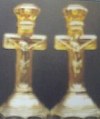Carnival Glass 101 | home Quick Reference to Carnival Glass Patterns on This Site
Dugan Glass - Part 1
DUGAN GLASS - Part 1
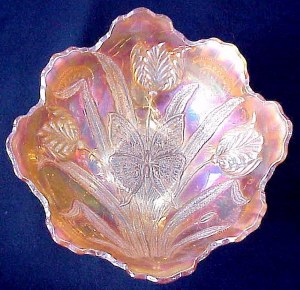 |
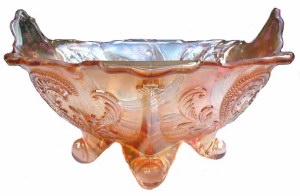 |
Customary shape for a marigold BUTTERFLY & TULIP footed bowl.
|
INVERTED FAN & FEATHER Exterior of Butterfly & Tulip Bowls
|
BUTTERFLY and TULIP: There is real joy in owning one of these impressive big bowls! It seems to be a pattern pleasing to most collectors. The mold work is precise and most examples in purple have exceptional iridescence. Depending upon the relaxation of this huge 10”-13” surface, they can be nearly flat. The large square bowls will usually command the highest prices, but the marigold examples can be pretty stunning in appearance, as well, many times found with a bright, radium type iridescence.
The more rounded, deeper shape of the marigold bowls are of near equal rarity. A single peach opalescent example is known, having rather deep ruffling.
For many years, the thought that possibly this interior mold plate (plunger) became a casualty of the 1912 fire has created conversation. When we visited the Fenton Art Glass Factory the end of March 2005, we saw a NEW red example in this Butterfly and Tulip pattern sitting in one of the workrooms.
We understand that a new interior mold was made for the Fenton versions of this pattern. The new bowls are made with a crimped edge treatment never used on the old bowls, and the exterior mold is a criss-cross design, rather than the Inverted Fan & Feather, which was used earlier. This new bowl has a collar base. So long as these details of the new bowl are firmly planted in memory, there need be no confusion. The marigold examples of the new bowls are exceptionally pretty!
Exterior pattern on the vintage bowls is called Inverted Fan & Feather or Feather Scroll. This bowl stands on four thick, curled feet having rounded ends. Prior to the introduction of carnival glass, as we know it, this pattern was used on a variety of shapes in iridized opalescent, colored glass, custard and opaque pink glass.
INVERTED FAN & FEATHER or FEATHER SCROLL: Exterior pattern for Butterfly & Tulip bowls. Exterior on new Fenton B/F/Tulip Bowls in a criss-cross design.
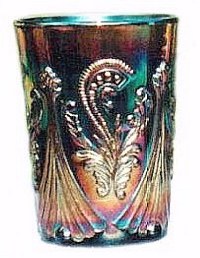 |
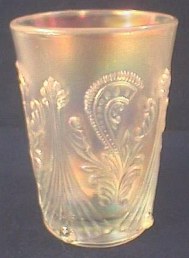 |
Purple FEATHER SCROLL tumbler 4 inch tall x 3 inch opening.(NO OLD tumblers confirmed in purple.)
|
White FEATHER SCROLL tumbler by St. Clair - not marked.
|
FEATHER SCROLL: or Inverted Fan & Feather design was included in production of non-iridized glass forms in 1900 while the plant operated under the name Northwood Works of National Glass Company. Custard glass, opalescent glass and an opaque pink, which has been erroneously called “Pink Slag.” It was simply made from a single heat-sensitive batch of glass which changed color when “warmed in”.
Pepper shakers, cruets, jelly compotes, toothpick holders and a punch set were only a part of the non-iridized line of products manufactured using this central pattern.
Other than use of the basic pattern as exterior for the Butterfly and Tulip bowls, carnival glass items are quite scarce in OLD carnival glass. One sugar bowl, missing its lid is known in marigold, along with a half dozen tumblers in marigold, for which a pitcher is not known to have surfaced. These are the only verified examples in OLD carnival glass.
Old tumblers have only been verified in marigold. New tumblers in ice blue, cobalt blue and white were made by St. Clair, circa 1969. Not all are marked. The cobalt blue ones were made for O. Joe Olsen and the Original Carnival Glass Collector's Society. These were marked on the base as such. About 250 of them were produced. St. Clair also made the toothpick holders in amethyst, marigold, cobalt blue and ice blue carnival glass. These pieces were very well done, and APPEAR to be old glass.
No OLD (Vintage) carnival Feather Scroll toothpick holders are known.
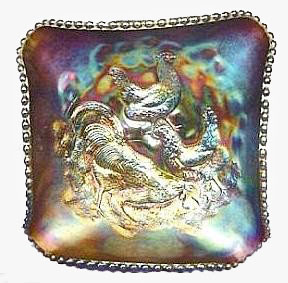 |
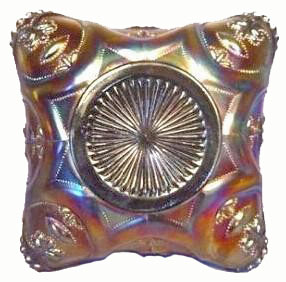 |
FARMYARD (Square) Bowl-one of the rarest shapes.
|
JEWELED HEART exterior
|
FARMYARD: One of the rarest of shapes in this profound pattern is the true square design. Nearly anyone who collects carnival glass desires one of these commanding bowls! The mold work, iridescence and departure from the “norm”, so far as pattern is concerned, combine to make an outstanding and treasured example of the workmen's excellence.
You will find a lovely six ruffle Farmyard already displayed and discussed on this 101 site (Click on F in the Pattern List), but we wanted to show you an example of a true square shape. The edge on the only known “plate” in this pattern does turn up slightly. Green is a rare color to have come from the Dugan years of 1909-1913, but three green examples in this pattern are known. 6” ruffled bowls in amethyst and peach opalescent, 8” ruffled in amethyst and green are the extent of shapes and sizes known in this exciting pattern.
Note: New Farmyard bowls and plates have been made by Fenton, for the exclusive sale by Singleton Bailey, in an array of colors. These should not cause any confusion, since they are not “reproductions” from the original mold and are clearly marked. Several years ago, L.G. Wright made some dome footed bowls with a 9” diameter in white, red and amethyst. Some of these are clearly signed: “MIMI” molded into the base. These have a glaring, shiny appearance, easily detected from the softer, more familiar iridescence found on the old examples.
JEWELED HEART: Victor was the name applied to this design when seen in original factory catalogs. It made its debut in non-iridescent form in January 1905. Until 1909, the pattern was used extensively in production of blue, green, and flint opalescent, along with a gold decorated color called Apple Green. A few blue opalescent Jeweled Heart pieces have been found with the Dugan D-in-a-diamond trademark.
More limited in carnival production but peach opalescent Jeweled Heart pieces appeared in the Fall 1910 Butler Brothers wholesale catalog. In addition to Farmyard, Dugan's Cherry, Petal & Fan, and Smooth Rays all carry Jeweled Heart as their exterior design.
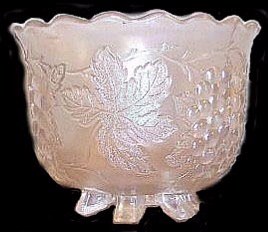 |
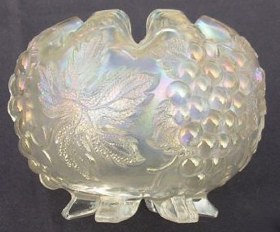 |
GRAPE DELIGHT Nutbowl in White.
|
GRAPE DELIGHT Rose Bowl in White.
|
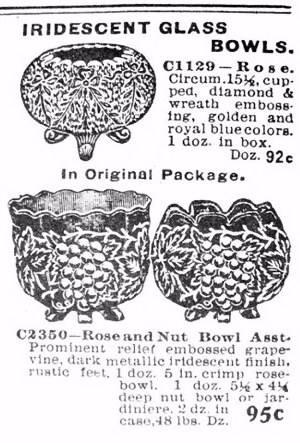 |
|
July 1914 Butler Bros. Ad-Note-Fenton GARLAND, as well as the Dugan GRAPE DELIGHT items in same ad!
|
|
GRAPE DELIGHT: This nut bowl shape with its straight sides is seen most often in marigold, amethyst and cobalt blue. There seem to be far fewer white nut bowls than white rose bowls in this pattern. Lavender and horehound are rare colors in the nut bowl shape.
Rose bowls have cupped in tops. One variation has a smooth, crimped edge, while the other has a scalloped top. This scalloped top is the harder of the two to locate. White is the most available color, followed by marigold and amethyst. Cobalt blue is more difficult to locate, but it should not be considered rare. They are to be found with a little effort. Pastel lavender and horehound, similar to the amber from Imperial are the rare colors. Spanning both the Dugan and Diamond production years, the design first appeared in wholesale catalogs in 1912, continuing through 1916.
Note: Both shapes were reproduced by L.G. Wright and Mosser in cobalt blue, purple, ice green, and ice blue. The newer examples in cobalt are lightly iridized and more transparent looking than the old. Since no ice blue or ice green examples are known in earlier manufacture, they should create no dismay. SOME of the Mosser pieces are trademarked, “M”, but many are not. Beware!
1914 BUTLER BROTHERS ad: Notice that the Grape Delight Nut bowl and Rose bowl are combined in this ad with a Garland Rosebowl from Fenton. Proof once again that all elements within a given ad are not necessarily from the same manufacturer.
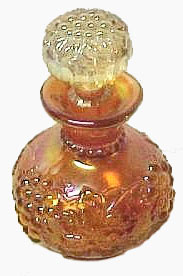 |
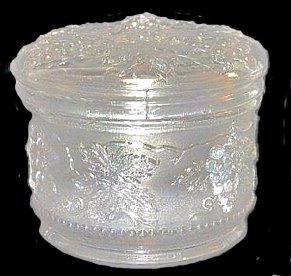 |
Dugan PERFUME BOTTLE has no cable, but rather a line of beads around the neck.
|
Dugan VINTAGE Powder Jar in VERY Rare White! The absence of the cable determines it to be of Dugan origin
|
VINTAGE PERFUME BOTTLE: Since Carl O. Burns called attention to this fact when writing his Dugan & Diamond Carnival Glass Book in 1999, surely there cannot be much controversy in this day and time in stating that this Perfume bottle does not and was never intended to go with the Northwood Grape & Cable Dresser Set. Copies of the Butler Brothers wholesale catalogs became available to the public along in the 1970s, researchers noticed that none of the ads for the Dresser Set included a perfume bottle. Then, several shards from the Helman diggings revealed a complete stopper in this pattern, which created the conclusive evidence of Dugan manufacture. While collectors may always continue to place this perfume with the dresser set, we must conclude that to be incorrect.
As we take a close look at the important differences in the two patterns, we notice that:
1. This perfume bottle has no cable encircling the piece, as all Grape & Cable items are known to have.
Instead, it has a row of beads around the neck of the bottle.
2. Grape and Cable items have alternating bunches of grapes separated by grape leaves. The important
difference in this perfume bottle is: the bunches of grapes are super-imposed over a grape leaf, which
is clearly seen protruding from under the bunch of grapes. The Grape and Cable pattern does not have
this.
3. In taking a close look at this perfume bottle and the Vintage Powder Jar, we discover the patterns to be
identical.
Since the hollow stopper is prone to damage, having a perfect example in either marigold or purple is most fortunate. Marigold is more difficult to locate, but the purple ones probably create the most excitement.
VINTAGE POWDER JAR: You will notice a row of beads around the base of the jar, with the same bunch of grapes super-imposed upon the leaves, just as the perfume bottle has. Now we begin to see the clearer picture emerging! This powder jar and the perfume bottle were intended to compliment one another! At this point, we can surely all agree that neither of these elements were ever intended to be accompanied by Northwood Grape and Cable Dresser Set components. The very likely scenario is this: The shards of the perfume bottle from the Helman diggings were misidentified, leading to previous years of confusion.
Although the powder jars are easier to find than the perfume bottles, there remains a shortage of lids. The lids are of much thinner glass, lighter in weight than the base, so we must assume the casualty rate to have been high with time and use.
Marigold jars are found most often but usually are missing the lid. Amethyst is more difficult to locate, but it is the cobalt blue examples which present quite a challenge. They are quite rare. The zenith of rarity comes with white examples. So few are known, it would be difficult to venture a guess as to the number.
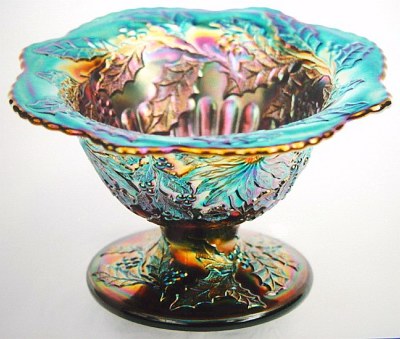
CHRISTMAS Compote in Amethyst
CHRISTMAS COMPOTE: The execution of design combined with masterful mold makers art makes this one of the most desirable pieces in the entire spectrum of carnival glass! Whether marigold or amethyst is your choice, this is one spectacular and impressive specimen………one of the very best from the Dugan years!
The quality of iridescence particularly on the amethyst examples is usually breathtaking, although it is said that marigold is more rare. The fact is: neither color presents itself very often.
In the spring of 1997, the original Dugan mold for this Christmas Compote suddenly appeared in the hands of an enterprising West Virginian. Reportedly, this mold weighs in at a whopping 400 pounds, having the D in a diamond trademark molded into the exterior surface. In short order, a reproduction was on the market. Fenton Art Glass Co. produced a limited number for Antique Publications, Marietta, Ohio. The Fenton logo appears with the initials AP on the base, to avoid confusion with the old compotes. Ice blue, red and topaz (vaseline)opalescent are the colors to be encountered. They were quite expensive for reproductions, retailing at $200-$250 each. There was some interest observed from vintage collectors, but they have not detracted from the original desire for and interest in ownership of the old examples!
An attempt was made to market them by advertising in Club Newsletters, but most of the Editors who were contacted declined the offer, saying that collectors Clubs' intent had always been to promote vintage carnival glass.
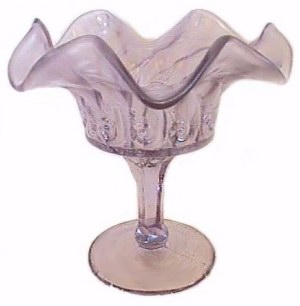
Lavender CONSTELLATION Compote
CONSTELLATION Compote: This soft shade of lavender is quite unusual. White is the most prevalent color and marigold is hard to locate. Amethyst examples are very scarce. Peach opalescent compotes are seldom found, and eagerly sought after. The name Constellation derives from the interior pattern, created for use when carnival glass came into fashion. A variation of the S Repeat pattern is seen on the exterior, leading some collectors to call it Sea Foam. If there are blue compotes in this pattern, we do not know of such. Carl O. Burns mentions one example having a frosty white top and marigold stem. Perhaps it was an experimental piece? The Constellation pattern appears on no other shape.
When this compote was made in crystal, prior to the carnival era, it was called a jelly compote, having only the S Repeat exterior.
Dean & Diane Fry ~~1/06
Have you made that noble request: “Lord, what would you have me to do?”
Requests for health, healing, success, and even spiritual power are not wrong, but they can become selfish prayers if they do not flow from a heart determined to obey God. Jesus said, “He who has My commandments and keeps them, It is he who loves Me. And he who loves me will be loved by My Father” (John 14:21)

Should you care to contact the Frys, their email address is:
Search Our Sites
back to Carnival Glass 101
Our other sites you may enjoy:
Everything you EVER wanted to know about Indiana Glass
Great Reference for Newer Carnival Glass.
Complete Glassware Catalogs Available to Download
Questions? Comments? Suggestions? Broken Links? Corrections?
Your Friendly Webmaster is here to help!
